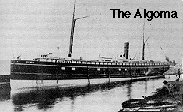
![]()

|
Ninety Fathoms Down: Canadian Stories of the Great Lakes.
Mark Bourrie. Subject Headings:
All grades / All ages.
**1/2 /4
|

![]()

|
Ninety Fathoms Down: Canadian Stories of the Great Lakes.
Mark Bourrie. Subject Headings:
All grades / All ages.
**1/2 /4
|
The Great Storm of 1913 had just about every kind of powerful atmospheric element known to the Great Lakes region: blinding rain, hail, sleet, snow, hurricane winds. Some of the lowest barometric pressures in the history of Canadian meteorology were recorded in the midst of the storm but most barometers in the worst of it ended up on the bottom of the Great Lakes. At the time it raged, nobody had any idea of its severity. Communications between the cities of the Great Lakes were knocked out on the first day of the storm. Bits of news made it through by telegraph, when messages were rerouted on lines away from the main blast of the storm, but not enough information got through for people to understand the storm's power. No one, especially along Lake Superior and in southwestern Ontario, needed news reports to realize they were in the middle of a disaster.
 The passage above describes the worst single disaster on the Great lakes
when at least forty ships were sunk and 248 sailors lost their lives.
Included in the losses were the James Carruthers, one of the
largest freighters on the Great Lakes, on her third voyage. Another ship,
the lake freighter Matao, beached three hundred meters from shore
and would require more than a year to refloat on Lake Huron.
The passage above describes the worst single disaster on the Great lakes
when at least forty ships were sunk and 248 sailors lost their lives.
Included in the losses were the James Carruthers, one of the
largest freighters on the Great Lakes, on her third voyage. Another ship,
the lake freighter Matao, beached three hundred meters from shore
and would require more than a year to refloat on Lake Huron.

Highly recommended.
Marsha Kaiserman is Head of Conferences Cataloguing at Canada Institute for Scientific and Technical Information (CISTI) in Ottawa.
To comment on this title or this review, send mail to cmeditor@mts.net.
![]()
Copyright © 1996 the Manitoba Library Association.
Reproduction for personal use is permitted only if this copyright notice
is maintained. Any other reproduction is prohibited without permission.
Published by
The Manitoba Library Association
ISSN 1201-9364
![]()